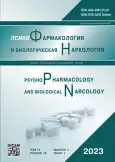Chronobiological aspects of the anti-stress effect of anxiolytics
- Authors: Ovanesov K.B.1, Beyer E.V.2, Kaminskaya O.V.2, Elbekyan K.S.2, Skornyakov A.A.2, Aleksanova E.M.2
-
Affiliations:
- North-Western State Medical University named after I.I. Mechnikov
- Stavropol State Medical University
- Issue: Vol 14, No 1 (2023)
- Pages: 40-48
- Section: Experimental Neuropharmacology
- Submitted: 24.03.2023
- Accepted: 24.03.2023
- Published: 11.05.2023
- URL: https://journals.eco-vector.com/1606-8181/article/view/321620
- ID: 321620
Cite item
Abstract
BACKGROUND: A stressful event, being a disturbing factor, is invariably accompanied by the disorganization of biological rhythms.
AIM: To examine the effects of stress and pharmacological substances on two models of the temporal organization of behavior, i.e., circadian locomotion and swimming dynamics in rats.
MATERIALS AND METHODS: The daily dynamics of rat mobility were assessed in a specially designed device consisting of living cells connected to a computer. Each cell is connected by a lever and a hinge with a button. When the rat moved from one end of the box to the other, the contact was closed, and the program autonomously summed up the number of such movements for each hour of the experiment. The total number of transitions was counted in 3 h, followed by the construction of a chronogram of the circadian rhythm of mobility. To assess the effect of substances on the circadian rhythm, anxiolytics diazepam (0.1 mg/kg), tofisopam (10 mg/kg), and epiphyseal hormone melatonin (0.1 mg/kg) were injected intraperitoneally into rats. Rats that received the same volume of saline injections (0.5 mL) served as controls.
RESULTS: Substances with anxiolytic properties, benzodiazepine derivatives diazepam (0.1 mg/kg) and tofisopam (10 mg/kg), and epiphyseal hormone melatonin (0.1 mg/kg), similarly eliminated stress-induced dysrhythmia in rats. Under their influence, the circadian rhythm of motor activity was normalized, and adaptive shifts were observed in the temporal dynamics of forced swimming.
CONCLUSION: A single stressful event disrupts the dynamics of daily mobility in rats. Diazepam, tofisopam, and melatonin, while differing in potency, generally alleviate these disorders. In particular, anxiolytics restore the rhythm in animals highly sensitive to stress. The studied substances reorganized the temporal dynamics in rats subjected to forced swimming and increased the proportion of long-period oscillations. Primary or secondary elimination of stress dysrhythmia is an important factor in the specific action of anxiolytics.
Keywords
Full Text
About the authors
Karen B. Ovanesov
North-Western State Medical University named after I.I. Mechnikov
Author for correspondence.
Email: ovanesov2007@mail.ru
ORCID iD: 0000-0001-7325-8027
SPIN-code: 1598-9971
Dr. Sci. (Pharmacology), assistant professor
Russian Federation, 41, Kirochnaya str., Saint Petersburg, 191015Edward V. Beyer
Stavropol State Medical University
Email: karokris@mail.ru
ORCID iD: 0000-0003-3248-6212
SPIN-code: 3411-1334
Dr. Sci. (Pharmacology), professor
Russian Federation, StavropolOlga V. Kaminskaya
Stavropol State Medical University
Email: kaminskaya.olga2014@yandex.ru
SPIN-code: 8878-1121
assistant lecturer
Russian Federation, StavropolKarine S. Elbekyan
Stavropol State Medical University
Email: obiochem@stgmu.ru
SPIN-code: 4449-1250
Dr. Sci. (Biol.), professor
Russian Federation, StavropolAnton A. Skornyakov
Stavropol State Medical University
Email: shcrb@mail.ru
Cand. Sci. (Med.)
Russian Federation, StavropolEkaterina M. Aleksanova
Stavropol State Medical University
Email: skkpc26@mail.ru
SPIN-code: 9359-9751
doctor
Russian Federation, StavropolReferences
- Becker-Krail D, McClung C. Implications of circadian rhythm and stress in addiction vulnerability. F1000Research. 2016;5:59. doi: 10.12688/f1000research.7608.1
- Morin CM, Carrier J, Bastien C, et al. Sleep and circadian rhythm in response to the COVID-19 pandemic. Can J Public Health. 2020;111(5):654–657. doi: 10.17269/s41997-020-00382-7
- Arushanyan EB, Beier EV. Melatonin: biologiya, farmakologiya, klinika. Stavropol: STGMU; 2015. 395 p. (In Russ.)
- Madsen BK, Zetner D, Møller AM, Rosenberg J. Melatonin for preoperative and postoperative anxiety in adults. Cochrane Database Syst Rev. 2020;12(12):CD009861. doi: 10.1002/14651858.CD009861.pub3
- Papp M, Litwa E, Gruca P, et al. Anxiolytic-like activity of agomelatine and melatonin in three animal models of anxiety. Behav Pharmacol. 2006;17(1):9–18. doi: 10.1097/01.fbp.0000181601.72535.9d
- Shchetinin EV, Baturin VA, Arushanyan EhB, et al. Bioritmologicheskii podkhod k otsenke prinuditel'nogo plavaniya kak ehksperimental'noi modeli depressivnogo sostoyaniya. Zhurnal vysshei nervnoi deyatelnosti imeni I.P. Pavlova. 1989;39(5):536–542. (In Russ.)
- Tang M, Huang H, Li S, et al. Hippocampal proteomic changes of susceptibility and resilience to depression or anxiety in a rat model of chronic mild stress. Transl Psychiatry. 2019;9(1):260. doi: 10.1038/s41398-019-0605-4
- Yu X, Franks NP, Wisden W. Brain Clocks, Sleep, and Mood. Crusio WE, Dong H, Radeke HH, editors. Advances in Experimental Medicine Biology. 2021;1344:71–86. doi: 10.1007/978-3-030-81147-1_5
- Ovanesov KB, Shabanov PD. Assessment of retinal photosensitivity as an objective indicator of expression psychodense effect. Reviews on Clinical Pharmacology and Drug Therapy. 2021;19(2):211–220. (In Russ.) doi: 10.17816/RCF192211-220
- Ovanesov KB, Shabanov PD. Retina photosensitivity indexes as an objective indicator of expression of psychostimulating effect. Reviews on Clinical Pharmacology and Drug Therapy. 2021;19(3):313–326. (In Russ.) doi: 10.17816/RCF193313-326
- Corr R, Glier S, Bizzell J, et al. Stress-related hippocampus activation mediates the association between polyvictimization and trait anxiety in adolescents. Soc Cogn Affect Neurosci. 2022;17(8):767–776. doi: 10.1093/scan/nsab129
- Beigi B, Shahidi S, Komaki A, et al. Pretraining hippocampal stimulation of melatonin type 2 receptors can improve memory acquisition in rats. Int J Neurosci. 2019;129(5):492–500. doi: 10.1080/00207454.2018.1545770
- Ergenc M, Ozacmak HS, Turan I, Ozacmak VH. Melatonin reverses depressive and anxiety like-behaviours induced by diabetes: involvement of oxidative stress, age, rage and S100B levels in the hippocampus and prefrontal cortex of rats. Arch Physiol Biochem. 2022;128(2):402–410. doi: 10.1080/13813455.2019.1684954
Supplementary files











